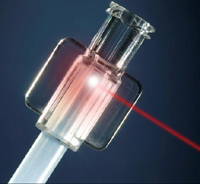|
Medical Device Manufacturing: Components Bonding and
Joining Techniques
Medical
devices whether temporary or permanent, used externally or
inside the body, are becoming more complex and more
sophisticated both in terms of their performance
specification and structural complexity. Medical devices
have complex shapes that cannot be molded directly. As a
consequence, many devices currently used are
multi-component and require methods of assembly in their
production.
Many types
of medical devices are made of plastics which are required
to be joined together in some manner. In these cases, the
plastic parts may need to be separately made and joined
together. So, Joining and Bonding are critical steps in
manufacture of the components from polymers and polymeric
composites which are used in manufacturing of Medical
Devices.
Medical
devices in every aspect of their production demand highest
level of quality. Reliability, reproducibility and the
assembly of sub components are also critical in
manufacturing of Medical products. Non-compatible
materials (e.g. Mix-matched polymers) used in the
manufacture of medical devices pose difficulties in the
assembly process. The bonding and joining technique must
not interfere with the function or standards applied to
Medical Device.
One of the
most prevalent concerns when bonding materials for medical
device manufacturing is how to get a strong bond between
mismatched substrate surfaces. Generally, when bonding
like materials, there are adhesives available that will
strongly bond the two surfaces at the interface of the
substrates. However, in many medical device manufacturing
scenarios, the need to bond different materials with very
dissimilar physical and chemical properties frequently
arises. For example, a reasonably rigid material such as
polycarbonate (PC) may need to be bonded together to a
more elastic polyethylene (PE) material. Since the
chemical properties of these materials is quite different,
they will tend to bond differently to various adhesives. A
certain adhesive may bond well to the PC, but not well, if
at all, to the PE, and vice versa.
There are
methods to chemically treat the surface of one or both of
the materials using primers, or other mechanical means to
get a strong adhesive bond. While many of these chemical
methods work quite well, they require the use of materials
that may expose the manufacturer to dangerous or toxic
matter. Such materials may also require expensive or
time-consuming disposal methods. Most importantly, many
toxic or dangerous materials cannot be used in the
manufacture of medical devices as they are going to be
implanted in the human body.
Nowadays,
there are thousands of grades of polymers available at the
market for Medical Device Manufacturing. These cover a
wide range of properties, from soft to hard, ductile to
brittle, and weak to tough. The wide variety of polymers
and polymeric composites makes it possible to select and
even customize the material to specific application.
As the
requirements for the components increase, so do the
requirement of joining. Joints in Medical Device
Manufacturing are necessary always when; part integration
is impossible because of complexity and/or high cost,
using different materials in the same component,
disassembly is required and repair of damage is needed.

Joining is
generally the final step in any fabrication cycle. The
effectiveness of joining operation can have a large
influence on application of any polymer or composite
material used in Medical Device production.
Blood
and gas filters, IV spikes, drug delivery systems,
surgical tools, diagnostic cassettes, fluidic devices,
cardiometry reservoirs, face masks, implantable devices,
insulin pumps, surgical gowns, blood donation kits,
dialysis tubes, disposable clothing, pump cylinders, blood
basins, sensor components, dialysis systems, condiment
dispensers and blister packages, are some of the common
Medical Products and Components which are using Plastic
Joining and Bonding processes in their manufacturing.
The methods
for joining plastics and composites can be divided into
following major categories: Mechanical Fastening, Adhesive
and Solvent Bonding, And Welding.
-
Mechanical Fastening :
Mechanical fastening has
limited applications in Medical Device assembly.
Mechanical fastening presumes the use of additional parts
such as polymeric screws, bolts and it involves the use of
separate fasteners or it relies on integrated design
elements such as snap fit or press-fit joints.
Mechanical fastening can be
used to join both similar and dissimilar materials.
The one advantage of
Mechanical fastening is ease of disassembly. While,
Disadvantages include reduced aesthetics, poor hermetic
sealing and increased inventory.
-
Adhesive Bonding And
Solvent Bonding :
In Adhesive Bonding, an
adhesive is placed between the parts to be bonded where it
serves as the material that joins the part and transmits
the load through joint. Adhesive bonding involves the use
of a polymeric adhesive, which undergoes a chemical or
physical reaction, for eventual joint formation.
Adhesive bonding is well
regarded in the industry because it does not have the
health and safety issues that solvent welding has. In
addition, adhesive bonding does not require the high
capital equipment costs as do ultrasonic or vibration
welding.
No one adhesive technology can
fulfill all requirements in bonding disposable medical
devices. A balance of adhesive properties is needed to
assure successful bonding of medical devices. The types of
adhesives commonly used for medical device assembly
include cyanoacrylate, lightcurable cyanoacrylate,
light-curable acrylics, epoxies, urethanes and dual
ultraviolet (UV)/moisture curable silicones.
Many medical devices,
including reusable surgical instruments like endoscopes
and laparoscopes, are assembled using a variety of
biocompatible adhesives. These adhesives must be able to
tolerate repeated sterilization cycles that may include
steam autoclaving, chemical treatment, and radiation
Anaerobic sealants, cyanoacrylates, light-curable
acrylics, and silicones are used in diverse lifesaving
applications ranging from automotive air-bag sensors to
catheters and blood oxygenators.
Page
1 :
2 :
3 |
